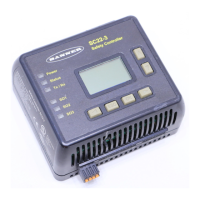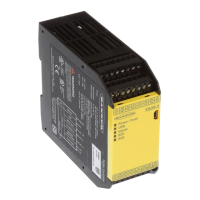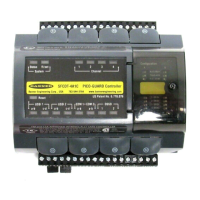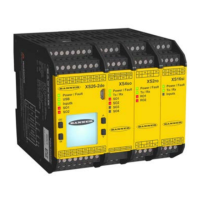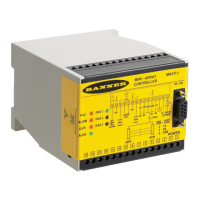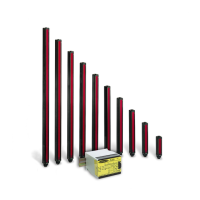Do you have a question about the Banner Sure Cross DXM700-Bx and is the answer not in the manual?
Overview of the DXM700's hardware configurations and assembly.
Details the various automation protocols supported by the DXM700.
Explains the DXM700's use of Modbus for data exchange and communication.
Information on downloading and using the DXM Configuration Software for setup.
Technical drawings and measurements of the DXM700 controller.
Initial steps for setting up the DXM700, including power and network configuration.
Guides on configuring the DXM700 using the software and traditional setup modes.
Details the manufacturer's warranty policy for Banner Engineering Corp. products.
Configuration options for MultiHop radio using DIP switches, including mode and power settings.
Overview of Modbus registers for the MultiHop Radio Board Module.
DIP switch configurations for the Performance Gateway Radio Module.
Details Modbus registers for the DX80 Performance Gateway.
How to reorder registers for efficient data access with DX80 Performance models.
Configuration of DIP switches on the base board for various functions.
Verifying Ethernet cable connection and configuration settings.
How the USB port is used for programming and console output.
Description of internal local registers and their Modbus mapping.
Instructions for applying power to the DXM700-Bx Wireless Controller.
Details on connecting RS-485 communication pins on the base board.
Details on configuring RS-485 ports as Modbus master or slave.
Information on the base board's PNP outputs and their Modbus registers.
Information on installing GSM/LTE cellular modem boards onto the base board.
Voltage requirements for the cellular modem to operate correctly.
Steps to activate and use the DXM's cellular modem for remote connectivity.
Accessing and configuring processor's local registers via the LCD menu.
Viewing information about the last data sent to the webserver.
Navigating the ISM Radio menu for binding, site survey, and radio ID.
Accessing system parameters like ISM Radio, Ethernet, and Modbus ID via LCD.
Viewing system settings and parameters for debugging network connections.
Protecting the DXM LCD menu system with a passcode.
Controlling bi-color LEDs using Modbus registers for the LCD board.
Guidelines for assigning Modbus Slave IDs for the DXM700's slave port.
How the DXM700 operates as a Modbus master and slave.
Overview of Modbus Slave IDs for DX80 Gateway and MultiHop networks.
Setting communication timeouts for Modbus transactions, especially in MultiHop networks.
Setting up Modbus TCP client communications over Ethernet.
Setting up scheduled events for local register changes based on time or conditions.
Configuring login and password for webserver data security and configuration access.
Understanding data flow, configuring registers, and managing configuration files.
Steps to configure the DXM700 for EtherNet/IP communication with PLCs.
Configuring the DXM700 to send email or SMS alerts based on threshold rules.
Handling of failed data push attempts over Ethernet and cellular connections.
Explanation of the GSD file for PROFINET IO device description.
Overview of the PROFINET IO data model structure for the DXM controller.
Steps to enable and configure PROFINET IO connection for the DXM700.
Information on the nine slots available to accommodate DXM Controller data.
Guides on installing GSD files and changing IP address/device name in TIA Portal.
Details on the DXM file system, EEPROM, and micro SD card file management.
Guide to update the DXM processor firmware using the DXM Configuration Tool.
Procedure to clear the password on DXM controllers, noting data loss.
List of available documentation and manuals for the DXM700.
Information on firmware updates, website resources, and feature requests.
Contact information for Banner Engineering Corp. headquarters.
Details for the Mexican importer of Banner Engineering products.
FCC and ISED certification details for 900 MHz, 1 Watt radios.
FCC and ISED certification details for 2.4GHz transmitter modules.
General warnings regarding installation and operation of the device.
The limited warranty terms for Banner Engineering Corp. products.
| Model | DXM700-Bx |
|---|---|
| Category | Controller |
| Wireless Technology | Sure Cross |
| Radio Frequency | 900 MHz |
| Data Rate | Up to 250 kbps |
| Modulation | FHSS |
| Power Supply | 10 to 30 V dc |
| Housing Material | Polycarbonate |
| IP Rating | IP67 |
| Protocol | Modbus RTU |
| Frequency | 902 to 928 MHz |
| Current Consumption | 100 mA |
| Operating Temperature | -40°C to +70°C |
| Weight | 0.23 kg |
| Communication Interface | RS-485 |
| Communication Protocols | Modbus RTU |
| Operating Range | Up to 3 miles (4.8 km) line of sight |
